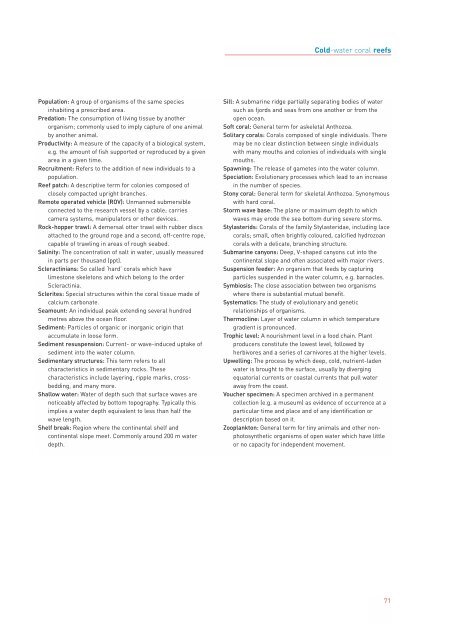Cold-water coral reefs - WWF UK
Cold-water coral reefs - WWF UK
Cold-water coral reefs - WWF UK
You also want an ePaper? Increase the reach of your titles
YUMPU automatically turns print PDFs into web optimized ePapers that Google loves.
<strong>Cold</strong>-<strong>water</strong> <strong>coral</strong> <strong>reefs</strong><br />
Population: A group of organisms of the same species<br />
inhabiting a prescribed area.<br />
Predation: The consumption of living tissue by another<br />
organism; commonly used to imply capture of one animal<br />
by another animal.<br />
Productivity: A measure of the capacity of a biological system,<br />
e.g. the amount of fish supported or reproduced by a given<br />
area in a given time.<br />
Recruitment: Refers to the addition of new individuals to a<br />
population.<br />
Reef patch: A descriptive term for colonies composed of<br />
closely compacted upright branches.<br />
Remote operated vehicle (ROV): Unmanned submersible<br />
connected to the research vessel by a cable; carries<br />
camera systems, manipulators or other devices.<br />
Rock-hopper trawl: A demersal otter trawl with rubber discs<br />
attached to the ground rope and a second, off-centre rope,<br />
capable of trawling in areas of rough seabed.<br />
Salinity: The concentration of salt in <strong>water</strong>, usually measured<br />
in parts per thousand (ppt).<br />
Scleractinians: So called ‘hard’ <strong>coral</strong>s which have<br />
limestone skeletons and which belong to the order<br />
Scleractinia.<br />
Sclerites: Special structures within the <strong>coral</strong> tissue made of<br />
calcium carbonate.<br />
Seamount: An individual peak extending several hundred<br />
metres above the ocean floor.<br />
Sediment: Particles of organic or inorganic origin that<br />
accumulate in loose form.<br />
Sediment resuspension: Current- or wave-induced uptake of<br />
sediment into the <strong>water</strong> column.<br />
Sedimentary structures: This term refers to all<br />
characteristics in sedimentary rocks. These<br />
characteristics include layering, ripple marks, crossbedding,<br />
and many more.<br />
Shallow <strong>water</strong>: Water of depth such that surface waves are<br />
noticeably affected by bottom topography. Typically this<br />
implies a <strong>water</strong> depth equivalent to less than half the<br />
wave length.<br />
Shelf break: Region where the continental shelf and<br />
continental slope meet. Commonly around 200 m <strong>water</strong><br />
depth.<br />
Sill: A submarine ridge partially separating bodies of <strong>water</strong><br />
such as fjords and seas from one another or from the<br />
open ocean.<br />
Soft <strong>coral</strong>: General term for askeletal Anthozoa.<br />
Solitary <strong>coral</strong>s: Corals composed of single individuals. There<br />
may be no clear distinction between single individuals<br />
with many mouths and colonies of individuals with single<br />
mouths.<br />
Spawning: The release of gametes into the <strong>water</strong> column.<br />
Speciation: Evolutionary processes which lead to an increase<br />
in the number of species.<br />
Stony <strong>coral</strong>: General term for skeletal Anthozoa. Synonymous<br />
with hard <strong>coral</strong>.<br />
Storm wave base: The plane or maximum depth to which<br />
waves may erode the sea bottom during severe storms.<br />
Stylasterids: Corals of the family Stylasteridae, including lace<br />
<strong>coral</strong>s; small, often brightly coloured, calcified hydrozoan<br />
<strong>coral</strong>s with a delicate, branching structure.<br />
Submarine canyons: Deep, V-shaped canyons cut into the<br />
continental slope and often associated with major rivers.<br />
Suspension feeder: An organism that feeds by capturing<br />
particles suspended in the <strong>water</strong> column, e.g. barnacles.<br />
Symbiosis: The close association between two organisms<br />
where there is substantial mutual benefit.<br />
Systematics: The study of evolutionary and genetic<br />
relationships of organisms.<br />
Thermocline: Layer of <strong>water</strong> column in which temperature<br />
gradient is pronounced.<br />
Trophic level: A nourishment level in a food chain. Plant<br />
producers constitute the lowest level, followed by<br />
herbivores and a series of carnivores at the higher levels.<br />
Upwelling: The process by which deep, cold, nutrient-laden<br />
<strong>water</strong> is brought to the surface, usually by diverging<br />
equatorial currents or coastal currents that pull <strong>water</strong><br />
away from the coast.<br />
Voucher specimen: A specimen archived in a permanent<br />
collection (e.g. a museum) as evidence of occurrence at a<br />
particular time and place and of any identification or<br />
description based on it.<br />
Zooplankton: General term for tiny animals and other nonphotosynthetic<br />
organisms of open <strong>water</strong> which have little<br />
or no capacity for independent movement.<br />
71
















